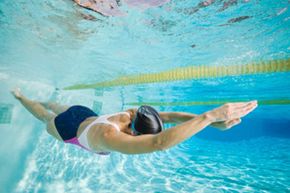Running is brutal. Just try to find an avid runner over the age of 20 who doesn't have chronic knee, hip, shin, ankle and muscle aches. That's because running is essentially jumping from foot to foot for minutes, even hours at a time [source: Burfoot]. Every time those feet hit the pavement, the body has to absorb the impact. This places tremendous stress on bones, tendons, muscles and other tissues, which can break down over time.
That's why many top runners, including several world-champion marathoners, are big believers in pool running. Pool running, as opposed to pavement running, is virtually "no impact." But pool running isn't only for injured or recovering runners. Pool workouts offer the same aerobic and anaerobic benefits of land workouts -- sometimes even more so -- with the added perks of increased motion resistance and keeping the body cool. Runner's World magazine calls pool workouts "hands-down the best cross-training for runners" [source: Wischnia].
Advertisement
Water exerts 12 times more pressure on an object than air, so the body has to work harder to move in the pool. A study by New York's Nicholas Institute of Sports Medicine found that simply walking through water at three miles (4.8 kilometers) per hour burns twice as many calories than keeping the same pace on land [source: Bloom].
Keep reading to hear more about the benefits of pool workouts for runners and then learn the best techniques for maximizing your speed and stamina.
Advertisement


